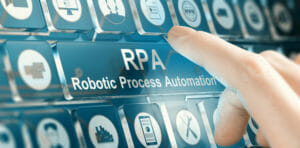Robotics technology has been around for decades but only recently gained popularity in the construction industry. In business, robotics software takes tedious and monotonous tasks away from the human workforce so employees can instead focus on projects that add value to their organizations. The technology is so versatile that companies in all industries are taking advantage, even those that have traditionally done everything with pen and paper. The technology has been proven to increase workplace efficiencies, and contractors who hope to advance in 2020 may want to consider how robotics software can play a part.
What Is Robotic Process Automation?
Robotic process automation – RPA – is a business process that uses technology and artificial intelligence to simplify everyday tasks. This technology takes the form of robotic software, sometimes called “bots,” to automate repetitive, high-volume tasks across all areas of business. RPA effectively acts as an electronic workforce and can provide data that helps leaders make more effective strategic decisions.
Uses for Robotic Process Automation
RPA is so adaptable that it can be used at construction sites and in back-office environments. At the construction site, RPA can take over some of the following tasks:
- Laying bricks in a precise, pre-determined pattern
- Reducing materials waste by planning how raw materials are cut or applied
- Manufacturing higher-quality materials
- 3D printing building supplies
- Planning the most efficient demolitions and using robots to raze a property
- Packing and moving materials safely and efficiently
But truthfully, RPA may be even more valuable assisting back-office workers. There are many administrative tasks bots can assist with, including:
- Processing invoices and sending confirmation emails to vendors
- Drafting general ledger entries, estimates, proposals, email responses, and monthly reports
- Updating supplier or subcontractor lists with new information found in emails or on the web
- Searching for candidates on job-posting websites
- Preparing spreadsheets to assist in tax preparation
- Scanning paper documents and filing them electronically
- Digitally tagging electronic documents with search terms
- Requesting and collecting onboarding documentation from new employees
- Performing routine maintenance on IT systems
- Scheduling new jobs
- Managing the network service desk
- Tracking trends and alerting management to economic changes
Contractors who adopt RPA will be in the minority. After all, paper blueprints and physical timesheets are still the norm. But those who take the leap have a lot to gain. With RPA technology, productivity can skyrocket (bots don’t need lunch breaks) and employee satisfaction will improve when busywork is eliminated. Mundane tasks like filling out paperwork or manually inputting payroll reports will be gone, freeing up workforce hours to spend time on more productive measures. Workplace safety will improve, fewer mistakes will be made, and managers will worry less about hiring employees when demand goes up; machinery can easily be scaled up if need be. The only struggle will be implementing new software. And that’s where a consultant can help.
Where to Begin
Specialized business consultants can perform an initial needs assessment for a construction company and oversee the roll out of new RPA technology. They will first want to verify all members of management are on board. Team leaders will need to train workers to perform their duties alongside bots, and managers may even need to hire new workers who have the skills needed to oversee the software. Without management buy in, RPA will fail before it even begins.
Another aspect of the consultant’s preliminary assessment will be to find specific software that can be adopted. Some companies will want to work within their current IT limitations, but others will be open to expanding their systems. The consultant will perform proof-of-concept exercises to see what the organization can handle. They can then roll out pilot programs to see how well the software will work in the new environment. Once the concept has been proven effective will they assist with a full software roll out.
Even with support from a professional consultant, legal guidelines may limit what RPA software a company can employ. For example, local ordinances may not allow the use of 3D printed structures, and municipalities may not accept blueprints or demolition plans generated by a bot. But the industry should take advantage of the technology when they can. RPA software has the potential to improve efficiencies across the board, and taking small steps now will set the groundwork for even bigger technology leaps in the future.

